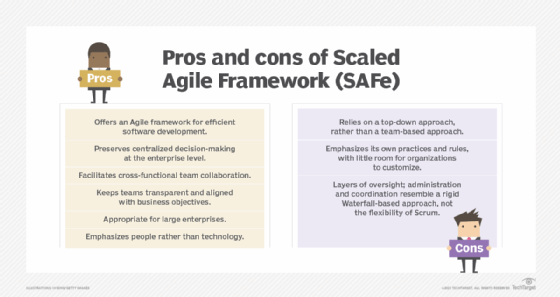
Khunatorn - stock.adobe.com
What does a SAFe Scrum master do differently?
What's the difference between a Scrum master and SAFe Scrum master/team coach? Not much, but you should understand their slightly distinct approaches in day-to-day practice.
People often ask, "What's the difference between a Scrum master and a SAFe Scrum master?" And, "What exactly does a SAFe Scrum master do?"
There is a great deal of overlap between these two accountabilities, but there are some small yet important differences as well.
These nuanced differences meaningfully change what is expected of a Scrum master. It depends on whether they operate as part of a single, independent Scrum team or as part of a wider release train in a scaled Agile environment.
Scaled Agile Scrum masters
With the recent SAFe 6 update, Scaled Agile has changed the Scrum master title to help distinguish its version of the accountability. The new SAFe role is called the Scrum master/team coach. The new name simultaneously makes it a bit clearer what this person does, but also a bit harder to parse for those familiar with the "pure" Scrum version of the accountability.
Let's dive into who these Scrum master/team coaches are, and why the name change was necessary.
What does a Scrum master/team coach do?
In Scrum, the Scrum master is accountable for the effectiveness of the team.
To fulfill this accountability, the Scrum master coaches the team in self-management and cross-functionality, and acts as a "true leader" to help the product owner and wider organization understand the importance of empiricism.
In an environment where a small number of teams work on a single product, this accountability is clear enough to give structure, but open enough to allow a practitioner to experiment and adjust how exactly to achieve these goals.
However, when a large number of dependent teams work in unison, things become a bit more complicated.
It is entirely possible for a team to do "pure" Scrum in a scaled environment, meaning they follow only the Scrum Guide as their source of truth. It's also possible that some or all of the teams must plan, integrate and deliver together in a tightly coupled way. Meanwhile, each team that works entirely separately is likely to create its own challenges.
What does a SAFe Scrum master do differently?
Therefore, the SAFe Scrum master/team coach has some additional responsibilities to the release train, the wider team-of-agile-teams that make up a complete value stream. These include the following tasks:
- Facilitate the planning interval event.
- Represent the team at regular "Scrum of Scrums" to help manage dependencies.
- Support the improvement of the overall release train performance, through sessions such as the problem-solving workshop and innovation and planning iteration.

Nothing expected of a SAFe Scrum master goes against the accountability defined in Scrum. However, additional activities are expected, and this may require some adjustments to how a person fulfills this accountability given the constraints of a multi-team, scaled environment.
So, the change of name helps to clarify that this is a slightly different role than the traditional one defined in the Scrum Guide. At the same time, for those who don't know a whole lot about Scrum, it is a bit clearer about what the role actually does.
Not all Scaled Agile teams use Scrum
Beyond an update and clarification of responsibilities, there is another reason to change the name from Scrum master to a team coach.
It can be confusing if there is a person called a Scrum master in a non-Scrum team. The team coach role encompasses the same basic responsibilities, without any pressure for teams to conform to the full Scrum framework.
Imagine that an operational support team joins a release train to support the Scrum teams as they build new features. These new team members might align to the same planning interval cadence, but otherwise have no need for fixed sprints, goals and other structures based in Scrum. A pull-based Kanban approach likely will suit their needs and enable them to deliver on their commitments.
However, since this team is now part of a release train, they still must participate in certain activities such as attend planning interval meetings, collaborate with other teams on the train, and escalate their risks and dependencies. As a result, they will benefit from the support of a team coach.
The Scrum team coach could be a full-time person, or simply an accountability picked up by an existing member of the team or release train. Either way, to make the train work as a whole, someone must be accountable for these things for each team.
In a Scaled Agile environment, whether they use Scrum or not, the team must still find a way to fulfill the same basic accountabilities of a Scrum master or team coach.
Scrum master vs. team coach: Slight differences but no conflict
The SAFe Scrum master/team coach is simply a person who is accountable for supporting a team to deliver value and be more effective.
This person can do so in the same way as a "pure Scrum" team might, but with some additional accountability to the release train to ensure the overall efforts achieve the combined value outcomes.
They are now also called a team coach to both better explain what the role is and to more easily provide that same support to non-Scrum teams.
There is no conflict between the SAFe Scrum master/team coach role, and the Scrum master accountability of the Scrum Guide. There are likely to be some differences in day-to-day practice in how they fulfill that accountability.








